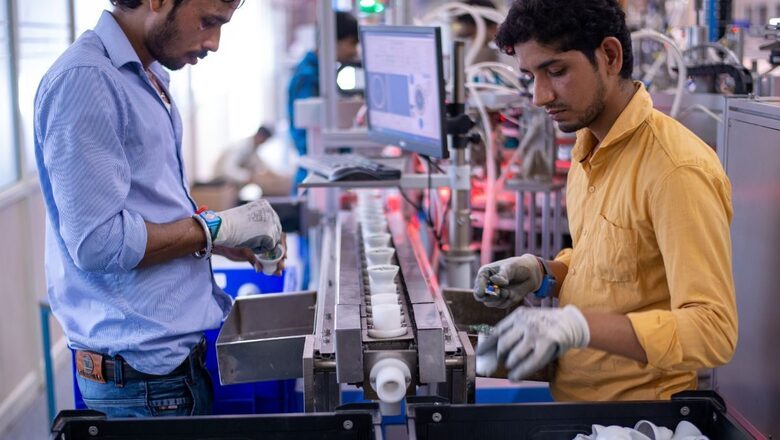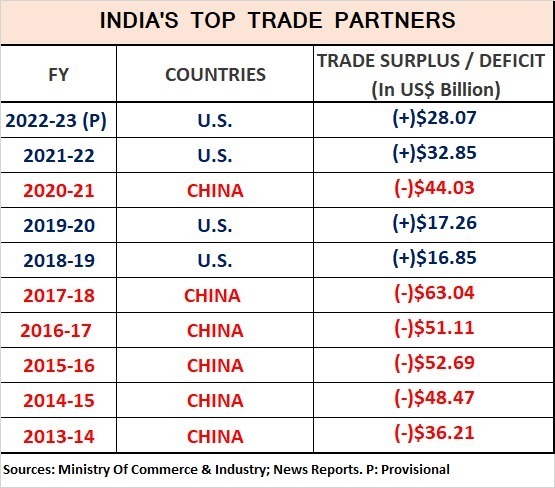
views
The United States has emerged as India’s top trade partner for the second consecutive year, tying up China to the second rank. The trade between India and the US has risen by 7.65%, reaching $128.55 billion during the 2022-23 period, up from $119.5 billion in 2021-22, and $80.51 billion in 2020-21 — the year China was India’s biggest trading partner, according to preliminary figures from the Ministry of Commerce.
Conversely, India’s bilateral trade with China decreased by roughly 1.5% to $113.83 billion in 2022-23 from $115.42 billion in 2021-22.

Strategic and foreign trade experts see the trade numbers as a small but significant move towards decreasing India’s reliance on Chinese imports; a move they feel was urgently required given New Delhi’s overdependence on Chinese imports, its persistent trade deficit with China and due to the unstable situation at several points along the Line of Actual Control (LAC) in eastern Ladakh.
“This is excellent news! Decoupling from China has begun, small but visible. Recoupling with the US is increasing, a better partner in all fields, from the economy to diaspora to strategic,” tweeted Gautam Chikermane, Vice-President of the New Delhi-based Observer Research Foundation (ORF).
However, others feel it is too early to make a definite call. “To predict India’s decoupling with China will be too early, though the government had taken steps to diversify the value chain,” said Rahul K. Mishra, Professor of Strategy and International Business, IILM University, New Delhi. “China remains a big source of semi-finished and finished products for India and the world. Pharma industry still depends a lot on China for APIs and other chemicals. Global companies such as Suzuki and MG depend on Chinese suppliers for chips,” he added.
Dr R. Rijesh, Assistant Professor, Institute for Studies in Industrial Development (ISID), New Delhi, said it could an indication of India’s deepening trade specialisation with the US. “This is because, since 2015, Indian exports to the US have grown faster than its exports to China. Also, India’s export basket to the US is more diversified than its export to China,” he said.
China’s rise on India’s import charts more or less coincided with its rise as global economic powerhouse while catering as a ‘factory of the world’. In 2011-12, for the first time, China topped as India imports source pushing down the UAE and the US to second and third spots. For five consecutive years between FY 2014 and FY 2018, China remained India’s top import source, at the same time widening the trade deficit from $36.2 billion to $63 billion in FY2018.
The next two financial years, that is, FY 2019 and FY 2020, China was pushed to the second spot by the US. In FY 2021, China reclaimed the top position, but the trade gap narrowed to $44.03 billion, mainly due to Covid-19 induced trade restrictions.
Despite losing its top spot for the past two fiscal years, India’s trade deficit with China has significantly increased to $83.2 billion in the last financial year, compared to $72.91 billion in FY 2022.
The alarming situation can be gauged from the fact that till January of the last fiscal Chinese trade deficit alone constituted over 31% of India’s total trade deficit of $230.3 billion.
India’s increasing reliance on China is evident in its overall trade figures as well. In fiscal year 2002, China accounted for just 3.9% of India’s total imports, but by fiscal year 2022, this figure had surged to 15.4%. Conversely, India’s exports to China have experienced lacklustre growth, with their share of the total exports increasing only marginally from 2.2% in FY02 to 5.0% in FY22.
Prof. Mishra further argues that India needs both the US and China for different kind of imports. “I don’t think US can replace China as Chinese semi-finished and finished goods are cost effective. With the US it is high tech product and technology,” he explained.

In a recent response in the Lok Sabha, the government, too, expressed its concerns regarding the widening trade deficit with China. “The trade deficit with China in 2004-05 was US$ 1.48 billion, which increased to US$ 36.21 billion in 2013-14, an increase of 2346%. Against this massive increase, the trade deficit with China has since increased by only about 102% to US$ 73.31 billion in 2021-22 from US$ 36.21 billion in 2013-14,” said the government, blaming major deficit escalation to its predecessor UPA government.
In FY22, India faced a trade deficit with China on several top commodities, including electronic components, computer hardware and peripherals, telecom instruments, organic chemicals, electronic instruments, consumer electronics, fertilizers, bulk drugs, and drug intermediates.
The government has attributed the rise in some of the imports like electronic components, computer hardware and peripherals and telephone components to “transforming of India into a digitally empowered society and a knowledge economy.”
“Some of the raw materials like Active Pharmaceutical Ingredients (APIs) and drug formulations, auto components, mobile phone parts are also used for making finished products which are also exported out of India,” the commerce and industry ministry said in its recent reply to Lok Sabha.
Chinese trade dominance remains complete however positive shoots of India’s efforts on reducing dependence on cheap Chinese imports is showing up. Not long back around 75% of toys in India were imported from China but the imports have plummeted by a staggering 67% since 2014-15 from $332.55 million to $109.72 million in 2021-22, according to government data.
While India’s pharmaceutical industry is the world’s third largest, China currently supplies about 70% of India’s pharmaceutical requirements, including crucial active pharmaceutical ingredients (APIs). To reduce this import dependence, the government has launched two production-linked incentive (PLI) schemes to support local manufacturing of these critical APIs, with a goal of reducing import dependence by 25% by next year.
In 2019, China dominated India’s solar module and cell market with a 78% share, followed by Vietnam. But now, thanks to measures such as import safeguard duty and the Rs 19,500 crore PLI scheme, India has become an exporter of solar equipment.
However, these green shoots are very few and far between. China, despite pushbacks from major economies, remains top trading partner to more than 120 countries, that is, over 60% of world’s total nations including the US, Vietnam, Taiwan, Russia, South Africa, Brazil, Saudi Arabia. In 2021, it overtook the US to become the EU’s biggest trading partner.
So, what is it about Chinese exports that make them so resistant to competition, even from the world’s leading economies, and how does India factor into this?
Experts feel India’s persistent trade deficit with China can be explained by several factors such as China’s lower labour costs, superior production efficiency, economies of scale stemming from mass production, and continued global supply chain dominance. Furthermore, the Chinese government has imposed substantial non-tariff barriers such as strict quality control and regulatory standards, which impede India’s export opportunities.
Despite multiple policy efforts and regulatory interventions, Chinese trade imbalance remains an Achilles’ heel and a critical question that policymakers in New Delhi are looking to address.
“It is better that India has been diversifying its export towards advanced countries. Focusing on a single partner country can constrain economic growth, create uncertainties and vulnerabilities, limit access to other growing markets and impede potential trade gains with other countries,” observes Dr Rijesh of ISID.
The assertion is backed by Prof. Mishra who adds: “India needs to increase trade from alternate sources like Taiwan, Vietnam, Bangladesh, and others to diversify its import basket. Make in India in strategic areas may also help. Vedanta Foxconn investment in chip fabrication is one good step in that direction. More such initiatives are required.”
Further, to achieve a more balanced trade relationship with China, India must prioritise the export of a diverse range of manufactured goods rather than relying excessively on a single commodity, said Dr Rijesh while giving an example of iron ore export from India to China.
According to news reports, during the fiscal year ending in March 2022, China purchased 21 million tonnes of Indian iron ore and concentrates, which accounted for 80% of New Delhi’s total exports of 26.32 million tonnes.
Besides, India holds a comparative advantage in manufacturing chemicals, engineering goods, precious stones, textiles, and auto components. Nevertheless, to compete effectively with China, India must enhance its supply capabilities, infrastructure, technology, and investment in large-scale manufacturing production units. By doing so, India can improve its productive efficiency, decrease reliance on imports, and bolster exports to China.
Some experts feel that New Delhi should use its vast market of over 1.4 billion people as leverage to negotiate the vexing border disputes with Beijing. Additionally, in the short term, India could strive to restore the status quo ante on the disputed border by decreasing Chinese imports.
But not many see it as a potential tool to budge the current Chinese leadership.
“It will put some pressure on China but restricting Chinese companies making strategic investment in India will help more,” feels Prof. Mishra, an assertion backed by Dr Rijesh as well who said border disputes are intricate issues that can’t be resolved solely through economic measures.”
Read all the Latest Business News, Tax News and Stock Market Updates here
















Comments
0 comment